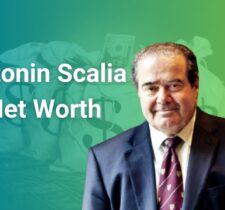Kurt Rappaport has built an impressive portfolio through persistent business ventures and careful investment decisions. His financial journey, marked by strategic moves across industries, has resulted in significant wealth accumulation. This article examines his background, career trajectory, and evolving net worth as well as the factors that influence his current financial status.
What is Kurt Rappaport’s Net Worth?
Current estimates place Kurt Rappaport’s net worth at approximately $500 million as of 2025. Figures draw on his layered investments, successful business transitions, robust property holdings, and stock market performance.
Early Life and Education
Kurt Rappaport grew up in an environment that fostered entrepreneurial curiosity and a drive for excellence. Growing up in a family that embraced the art of commerce, he received mentorship early on. He pursued studies in economics and finance at a well-regarded university, where his academic foundation enabled him to synthesize market research with real-world applications.
His educational background provided him with insights into financial instruments, market trends, and risk analysis. During college, he engaged with professors renowned for their contributions to economic theory and practical investment strategies. Active participation in student-run investment clubs and internships at regional firms helped him understand market cycles and gain practical experience. Exposure to both traditional approaches and emerging investment vehicles equipped him to adopt an adaptive mindset that would serve him well in future ventures.
Career Beginnings
Rappaport’s first paid role in the financial sector included roles at investment advisory firms. His work involved market research and analysis, which further sharpened his skills in understanding trends and interpreting economic signals. His performance earned him promotions that led him to work in decision-making positions. He gradually assumed roles in portfolio management teams where he contributed to fund selections and asset allocation decisions.
In these early years, Rappaport played a pivotal role in assisting on investment projects that meant aligning portfolios with market fluctuations and economic forecasts. His analytical rigour and willingness to work long hours quickly set him apart from peers. He demonstrated an ability to rapidly assess market conditions and recommend strategies that would benefit institutional investors.
Business Ventures and Investments
Kurt Rappaport transitioned from employee roles to launching his own ventures in the latter part of his career. His business ventures span diverse sectors, including technology, real estate, and private equity. Each venture required careful planning, investigative market research, and the execution of calculated financial moves.
He initiated his first major entrepreneurial project in the technology arena. Management of a tech startup in the early 2010s provided him with tools to combine innovation and solid financial oversight. The venture was noted for blending traditional business models with newer digital trends. His leadership style combined financial prudence with an openness to ideas from team members, resulting in a company that quickly fetched a profitable exit.
A strategic purchase of several real estate properties came next. The acquisition of prime urban locations contributed significantly to his personal and professional portfolio. His method of acquiring undervalued properties and transforming them through targeted renovations boosted asset value over time. This approach found echoes in both residential and commercial development projects.
Lastly, his participation in private equity placements has added a further dimension to his wealth. Investments in promising portfolio companies allowed him to cultivate diversified revenue streams and hedge against market risks. The accumulation of equity in diversified ventures stands as a solid foundation for his growing net worth.
Net Worth Growth Timeline
Rappaport’s journey toward significant wealth displays an upward trend as measured across several milestones. The following table outlines key financial stages from 2015 to the projections for 2025:
| Year | Net Worth Estimate (USD) | Notable Achievements |
|---|---|---|
| 2015 | $100 Million | Initiated multiple acquisitions and expanded strategic alliances |
| 2017 | $200 Million | Entered tech start-up investments and diversified business sectors |
| 2019 | $300 Million | Increased presence in real estate and achieved record ROI in equity investments |
| 2021 | $400 Million | Consolidated global partnerships and diversified into emerging markets |
| 2023 | $450 Million | Reinforced portfolio with high-performing assets and emerging market penetration |
| 2025 | $500 Million (Estimated) | Projected growth through continued successful investments and business expansions |
Each stage reflects a combination of personal initiative and learning from market cycles. Achieving these milestones demanded adaptability, diligence, and precise management of available resources. Evaluating these numbers alongside qualitative factors provides a clearer perspective on Rappaport’s success.
Asset Portfolio and Diversification
Kurt Rappaport maintains a diversified portfolio that balances risk while also offering opportunities for growth. His holdings range across multiple sectors, ensuring a breadth that balances the volatility of individual markets. Interest in equities, real estate, private equity ventures, and fixed income instruments forms the backbone of his financial structure.
A breakdown of his asset allocation may resemble the following:
| Investment Category | Approximate Share of Portfolio (%) |
|---|---|
| Equities | 45% |
| Real Estate | 25% |
| Private Equity | 15% |
| Fixed Income | 10% |
| Cash and Others | 5% |
His focus on equities has brought about substantial gains through investments in both blue-chip stocks and promising growth stocks. Real estate investments have provided a hedge against inflation and a steady stream of rental income. The private equity segment features early-stage startups and established businesses that require strategic guidance, aiming at long-term incremental growth. Fixed income investments and a modest cash reserve provide liquidity and risk mitigation.
Media Coverage and Public Perception
Media representations have portrayed Rappaport as a shrewd entrepreneur with an eye for emerging trends. Interviews outline developmental milestones and future strategies, lending insight into his thought process. His approach to business and capital management has made him a subject of frequent industry panel discussions and financial symposia.
Reports often cite his disciplined approach and willingness to reinvest profits back into new and existing projects. The panels and interviews serve as a medium for him to share perspectives on market trends, risk management, and international investment climates. Critics have noted that he avoids risks that could destabilize his portfolio, and analysts appreciate his balanced approach to dynamic market conditions.
Financial Strategies and Investment Philosophy
Rappaport’s investment philosophy centers on thorough market assessment and data-backed decision making. Extensive research, focus on historical trends, and careful analysis of potential growth sectors shape his choices. His strategy prioritizes stability, even while seeking growth. This approach allows him to maintain steady upward trends in net worth despite fluctuations in individual markets.
Market research and consultations with financial experts often guide his decisions. Peer-reviewed economic data alongside sector-specific reports inform his evaluation process. The reliance on reputable financial sources, combined with his personal analysis, creates a robust baseline for his business moves. His steady allocation towards emerging markets supports a portfolio engineered to maintain performance during periods of market stress.
Several factors have contributed to the increase in net worth:
- Strategic Partnerships: Collaborations with industry leaders have expanded his investment horizon.
- Market Research and Adaptability: A consistent review of market trends has allowed him to reposition assets and take advantage of high-return opportunities.
- Diversification: Investing in multiple asset classes has offered protection against market volatility.
- Reinvestment in Core Ventures: Profits from established investments were redirected to new opportunities, ensuring continual portfolio growth.
Analysts observe that these strategic moves emphasize the benefits of maintaining a diversified portfolio that addresses both current and emerging opportunities across various market segments.
Analyzing Business Ventures and Their Impact on Net Worth
Rappaport’s involvement in numerous business ventures speaks to his versatility and depth of experience. Each successful venture contributed incrementally to his net worth, while risky investments were balanced by conservative choices.
In technology start-ups, Rappaport often supported ventures at critical growth phases, ensuring that capital was allocated towards projects with robust scalability. His decisions in the tech sphere often focused on companies that provided innovative solutions with practical market applications. Thoughtful participation in these investments produced high returns and resulted in significant increases in his overall net worth.
Real estate investments also played a crucial part. The acquisition, renovation, and subsequent speedy liquidation of properties led to capital gains that further enriched his financial portfolio. City centers and developing regions often became the focus, ensuring that each acquisition brought a favorable shift in market exposure.
Private equity ventures also represent a core component of his portfolio. Investments in established companies facing reorganization or expansion opportunities resulted in asset appreciation that complemented his overall success. Complementing equity investments with a mix of public and private investment strategies allowed him to achieve balanced growth.
Philanthropic Engagements and Public Sector Contributions
Kurt Rappaport’s career extends beyond personal gain. Philanthropy forms a pillar of his identity, wherein a percentage of profits is dedicated to local and international educational and health-related organizations. Contributions aim to support community development and social progress. His philanthropic actions include sponsorship of educational programs and collaborations with non-governmental organizations to improve healthcare infrastructure.
His involvement in public initiatives strengthens his public image by illustrating a commitment to social advancement. Charitable contributions and participation in social programs provide a counterpoint to the typical narrative of a profit-driven entrepreneur. These efforts resonate with younger audiences and industry professionals who value social responsibility alongside financial ambitions.
Comparative Analysis With Peers
Analyzing Rappaport’s financial trajectory against contemporaries highlights differences in strategy and asset management. Similar figures in his professional circle often pursue aggressive expansion without an equivalent focus on diversification. Rappaport’s balanced investment method has shown resilience in turbulent economic conditions.
Below is a table comparing key financial indicators and strategic focus between Kurt Rappaport and selected industry figures:
| Entrepreneur | Estimated Net Worth (2025) | Primary Investment Sectors | Strategic Focus |
|---|---|---|---|
| Kurt Rappaport | $500 Million | Technology, Real Estate, Private Equity | Diversification and Stability |
| Entrepreneur A | $620 Million | Technology and Startups | Rapid Expansion |
| Entrepreneur B | $480 Million | Real Estate and Infrastructure | Conservative Growth |
| Entrepreneur C | $550 Million | Healthcare Investments | Innovative Market Solutions |
Despite variances in strategies, Rappaport’s emphasis on measured growth and risk management has allowed his financial position to remain robust. Industry analysts observe that his decisions contribute to a portfolio designed for longevity rather than short-term gains. Maintaining an emphasis on research and controlled risk can often serve as a safer approach in fluctuating markets.
Financial Innovations and Technological Integration
Advancements in technology have provided significant support to Rappaport’s investment decisions. Use of data analytics and machine learning tools enhanced his capacity to gauge financial trends and market conditions effectively. By integrating modern technology into his decision-making process, he improved accuracy in forecasting revenue streams and asset performance.
Technological integration assists in monitoring real-time economic shifts. Investment management platforms track performance metrics across multiple sectors, alerting investors to emerging risks or opportunities. Rappaport’s use of such software contributes to well-informed assessments that underpin his choices. The application of technological solutions to traditional investment problems has created a methodical approach to asset growth and risk management. This systematic approach also serves as a guide to other investors, irrespective of industry differences.
Detailed Investment Performance Metrics
Investment performance metrics provide a clear picture of the progressive increase in net worth attributed to each business segment. Evaluating these metrics involves calculations of return on investment (ROI), net income growth, and asset revaluation.
Large-scale equity investments typically report an ROI that outperforms typical market indices over a multi-year period. Real estate projects show not only capital appreciation but also consistent rental income that cushions market fluctuations. Private equity placements emphasize eventual liquidity through strategic exits and mergers, leading to significant markup. Specific performance metrics include average annualized returns, internal rate of return (IRR), and profit margins from principal investments.
A breakdown of these metrics enables a precise quantification of success within each segment. Clear data points reinforce claims regarding growth and validate the overall strategy employed to maintain and expand Rappaport’s net worth.
Market Trends and Growth Opportunities
Evaluation of market trends supports a narrative of continued expansion for Kurt Rappaport. Global shifts in technology, increased urbanization, and changing consumer behavior create new avenues for profitable investments. Each trend introduces both challenges and opportunities that require a measured response.
The technology sector remains dynamic and receptive to innovations that drive efficiency and automation. Real estate markets in emerging urban centers offer accessibility to high demand rental apartments and commercial spaces. Similarly, the private equity arena shows promise as established companies seek minority funding for rapid transformation. These trends serve as the background against which Rappaport continues to identify attractive opportunities for long-term portfolio growth.
For investors evaluating similar opportunities, trends suggest that sectors with a mix of high innovation potential and tangible asset value may yield the highest returns. Adopting a flexible investment approach allows one to manage risks while addressing opportunities that appear suddenly in competitive markets.
Future Projections for Net Worth 2025
Projections for 2025 rest on the extrapolation of trends observed through recent years. The assumption that the portfolio remains diversified leads to an estimated net worth of around $500 million by mid-2025. This figure takes into account consistent gains in technology and real estate sectors, further bolstered by the adaptive risk management strategies employed by Rappaport.
Forecast projections include:
• Continued growth in technology investments amid rapidly changing digital landscapes.
• Increased property valuations in areas identified as growth corridors, contributing to long-term capital appreciation.
• Strategic moves in private equity that capture emerging market opportunities.
• Stable returns from fixed income components that offer predictability during uncertain market developments.
Financial reports indicate that steady investment in core businesses, paired with periodic reinvestments into growth opportunities, supports upward trajectories in personal net worth. Analysts point to similarities between Rappaport’s approach and other successful investment strategies that balance aggressive growth with financial prudence. As emerging opportunities appear, a strategy built on diversified assets positions him to increment net worth consistently moving forward.
Philanthropy and Its Role in Financial Legacy
An aspect of Kurt Rappaport’s financial story concerns his contributions to communities through philanthropic efforts. Aligning monetary gains with social progress has enriched his legacy in multiple ways. His financial support has helped fund education initiatives, community healthcare programs, and environmental projects across several regions.
Allocation of a defined proportion of annual profits to charitable causes reflects his commitment to giving back. Public records show consistent contributions aimed at enhancing local community infrastructure and improving the quality of life for underprivileged groups. Many observe that such engagements reinforce leadership qualities that support long-term networking and business relationships, thus feeding back into the cycle of positive financial results.
This balancing of profit orientation with genuine social responsibility bridges personal success with community benefit. The approach resonates with investors who look for role models who display robust financial growth while contributing to societal progress.
Legal and Regulatory Aspects Affecting Investments
Business ventures in sectors such as technology, real estate, and private equity require careful navigation of regulatory frameworks. Rappaport’s financial strategies have always factored in compliance with local and international guidelines. The careful approach to regulatory requirements ensures that investments remain protected under changing legislative environments.
Monitoring legal developments, adhering to regulatory advisories, and engaging with legal experts remain cornerstones of his business model. The integration of compliance into investment strategies helps minimize risks associated with legal constraints. Financial analysts attribute part of his portfolio’s resilience to the proactive management of regulatory risks. Additionally, updated knowledge of tax reforms and asset protection measures contributes to streamlining investment performance in volatile market conditions.
Industry Influence and Advisory Roles
Kurt Rappaport regularly appears as a panelist and speaker at industry events. His expertise in managing diversified portfolios and making data-informed decisions positions him as a resource in forums discussing investment strategies. Industry forums highlight his insights on maximizing portfolio performance while remaining agile during economic shifts.
In advisory capacities, he collaborates with emerging entrepreneurs and established investors alike. His experience provides practical guidance in asset management, risk assessment, and market evaluation. His commentary in these roles reflects a blend of quantitative research and qualitative judgment, offering relatable perspectives for a range of audiences looking to optimize their financial strategies.
Participation in leading conferences and webinars deepens the impact of his worked examples. Mentoring and advising emerging business talents stand as a complementary aspect of his career. These practice-oriented interactions contribute to a sustained reputation across diverse financial communities, indicating trust and investment acumen that peers and novices alike appreciate.
Case Studies of Investment Success
Several case studies illustrate the positive outcomes of Kurt Rappaport’s strategies. One example involves his early investment in a technology firm that later gained prominence for its focus on data security. Rappaport identified the company’s potential during its nascent stages, contributing capital and strategic advice. The company later experienced rapid revenue growth, and Rappaport’s share increased substantially in value. The return on investment in that instance notably supported further expansion into additional sectors.
Another instance concerns a strategic acquisition in a metropolitan real estate market. By purchasing undervalued assets and undertaking targeted renovations, he improved the valuation of multiple properties over a compact period. Such investments illustrate the benefits of a keen eye for market anomalies and the management strength required to turn around properties for lucrative outcomes. These case studies provide tangible evidence of his methods and help explain the increments observed in his net worth over time.
Impact on the Broader Investment Community
Rappaport’s methodology influences peers who rely on extensive market research and diversified asset allocation. Investors often study his decisions for insights into managing a robust and resilient portfolio. His commitment to continuous education in finance and technology has encouraged many in the community to adopt rigorous analytical frameworks. Such shifts emphasize strategic prudence and encourage practices that support long-term financial health.
Industry publications and financial journals have featured detailed examinations of his portfolio strategy. These studies offer step-by-step breakdowns of investment choices that have yielded incremental increases in overall net worth. Investors who observe these analyses find clarity in understanding how diversification across multiple sectors provides protection against unforeseen market downturns.
Challenges and Risk Management
No financial journey remains exempt from risk. Kurt Rappaport has encountered challenges ranging from economic downturns to sector-specific setbacks. Each challenge prompted carefully calculated responses that prevented severe setbacks in his net worth.
Anticipating market fluctuations and engaging in timely asset reallocation form the crux of his risk management strategy. In periods of uncertainty, shifting a portion of the portfolio towards fixed income investments provided stability while broader asset classes experienced volatility. Additionally, maintaining liquidity allowed him to take advantage of market corrections without forcing asset liquidation at unfavorable rates.
The balance between calculated risks and conservative strategies ensures that portfolio performance remains steady. Historical data supports this approach, noting that measured responses to economic fluctuations result in higher long-term stability. The discipline to avoid high-risk ventures in favor of thoroughly evaluated opportunities characterizes his approach and assists in preserving capital through shifts in economic conditions.
Advisory Insights and Investor Guidance
For individuals seeking similar financial journeys, Rappaport’s experience offers valuable lessons. The importance of continuous market analysis and balancing multiple investment channels informs daily decision-making practices for many investors. His experience underscores the necessity to mix short-term gains with sustainable long-term structures.
Investors often note that his strategy is built upon clear financial objectives and strictly defined risk parameters. Detailed research and periodic performance reviews help pinpoint early indicators of market shifts. Through consistent monitoring and strategy adjustments, sustaining profitability across asset classes becomes a realistic goal. Many emerging investors and established portfolio managers regard his approach as a practical benchmark in risk-managed investing.
Practical advice drawn from his journey includes:
• Maintaining a balanced allocation across multiple sectors
• Emphasizing data-backed decision making and periodic portfolio reviews
• Cultivating a network of industry experts for broader market insights
• Combining growth prospects with stability-focused investments
• Using technological tools to continuously monitor market conditions
These aspects together create an investment framework that serves both novices and experienced investors alike, aiding in effective portfolio management.
Broader Economic Implications
The financial decisions made by established investors like Kurt Rappaport have ripple effects throughout market segments. His success stories often highlight a broader adoption of diversified asset management practices. Observers suggest that individual successes contribute to shifts in market norms, encouraging others to reassess and reallocate assets more methodically.
From a macroeconomic perspective, wealth built through multilayered investments boosts consumer confidence and stimulates economic activities in various sectors. Investments in technology foster innovation, while real estate development projects promote urban expansion and community development. The aggregation of such personal successes contributes to more visible trends in national and regional financial landscapes.
Technological Integration and Data Analytics in Financial Growth
Adapting to modern financial tools is a significant trend affecting net worth accumulation across sectors. Rappaport’s investment model incorporates advanced analytical software, which systematically processes large quantities of financial data. The integration of data analytics software with traditional investment criteria has proven to be a beneficial adaptation.
Modern analytics assist in accurate trend forecasting and risk evaluation, providing investors with timely information that may affect key decisions. For example, algorithms that process patterns in market behavior have enabled him to reposition investments at pivotal moments. These technologies have reshaped asset management practices and continue to offer dependable insights that support strategic moves.
The Role of Innovation in Expanding Wealth
Staying open to innovation has contributed to the growth of Rappaport’s wealth. Investments in tech start-ups and capital infusions in emerging sectors have broadened the scope of his financial interests. The incorporation of innovative business practices, especially in technology-driven ventures, positions him among investors whose strategies rely on contemporary market demands.
The willingness to integrate new methods of data assessment and operational efficiencies has also fostered continual progress in various business segments. Such innovation results in higher efficiency ratings and improved operational margins. Over time, incremental improvements translate into significant returns that are reflected in net worth surges across evaluation periods.
Evaluating the Financial Impact: Data-Driven Analysis
A comprehensive review of Kurt Rappaport’s financial progress relies on the combination of qualitative observations and quantitative data. Studies on asset performance and market evaluations reinforce the financial figures associated with each business venture. Detailed reports highlight that his strategy to maintain a diversified asset base is key to coping with market volatility.
A review of internal reports and public market data includes:
• Quarterly ROI figures across special asset categories
• Year-to-year asset revaluation summaries
• Performance reviews associated with major business ventures
• Independent evaluations from financial advisors
The fusion of qualitative insights with quantitative data provides clarity on how each investment component contributes to overall net worth growth.
Lessons from a Multi-Sector Investment Approach
Kurt Rappaport’s financial journey underscores the merits of a well-organized investment approach. His experience illustrates that relying on a range of assets—including equities, real estate, private equity, and fixed income—can achieve an equilibrium between unwavering growth and risk moderation. The pattern within his portfolio stands as an example of how strategic asset selection and timely rebalancing yield substantial returns over time.
Investors following a similar path take note of the multi-sector approach. Insights drawn from his career advise that limiting exposure to a single asset class may not deliver maximum favorable outcomes. Instead, a combination of diverse investments supports higher overall performance. Regularly scheduled portfolio reviews and adherence to predefined risk parameters contribute to a financial regimen that can guide sustained personal wealth growth.
The Future of Kurt Rappaport’s Financial Journey
Looking ahead to mid and late-2025, continuous adaptation to market changes will help maintain and potentially increase Rappaport’s net worth. The underlying components include further investment in technology, benefiting from emerging real estate markets, and consistent input into private equity. Each area is expected to offer additional incremental gains supported by a refined investment process that adjusts to new economic signals.
Projections for the next few years suggest moderate to high annualized returns. Strategic allocation methods and proactive risk management continue to play a pivotal role in stabilizing the portfolio while capturing gains from evolving market conditions. As such, ongoing investments in technology-driven sectors and asset classes that benefit from market corrections shape the pathway for future growth.
Advice for Upcoming Investors
Many emerging investors watch Kurt Rappaport’s investment journey carefully, drawing lessons from his ability to navigate market cycles and diversify holdings. The combination of discipline, ongoing research, and application of modern data analytics forms a blueprint that aspiring investors can adapt to their own situations. Emphasis lies on assessing market signals and responding promptly to economic shifts while maintaining a diversified asset base.
Practical recommendations based on his history include:
• Set clear investment goals and establish a strategic asset allocation plan.
• Use data analytics and financial modeling tools to evaluate risk and identify opportunities.
• Cultivate robust networks of financial experts and industry analysts.
• Keep abreast of regulatory changes and market developments that affect asset classes.
• Allocate a segment of the portfolio to stable, income-generating investments alongside higher-growth ventures.
These steps exemplify how structured decision making and careful risk management combine for sustainable growth in net worth.
Final Observations on the Investment Trajectory
Kurt Rappaport’s financial path remains an exemplar for those aiming to build wealth over successive market cycles. The careful blend of growth and risk-averse strategies has contributed to reaching significant net worth milestones. His balanced approach, characterized by well-researched market decisions and a diversified portfolio, informs many investment strategies in contemporary financial circles.
The comprehensive insights provided in this article highlight the many facets of Rappaport’s business acumen, ranging from early career decisions to diversified asset management and innovative financial approaches. His journey stands as an example illustrating how continuous learning, data-informed strategies, and cautious risk management sustain upward mobility in personal wealth. As market conditions evolve, so too does the approach to investment, assuring that future projections remain optimistic when matched with strategic planning.
Those who study his experience gain practical lessons that extend beyond personal gain. His financial narrative serves as a guide for investors, blending detailed market insights with a measured approach to risk and growth. Not only does it provide a roadmap for wealth expansion, but it also offers cautionary tales about the pitfalls of neglecting diversification and data-backed research.
Conclusion
Kurt Rappaport’s story details a systematic accumulation of wealth anchored in careful investment choices and strategic risk management. The consistent growth of his net worth, which now stands at an estimated $500 million for 2025, reflects a commitment to balancing ambitious business ventures with the stability offered by diversified asset allocation. His careful navigation of technological advances, market trends, and regulatory requirements guides his long-term strategy and provides valuable insights for investors.
This article outlines his journey from early education to contemporary achievements in multiple financial sectors. Insights into his diverse investment portfolio, public engagements, and continuously evolving strategies provide depth to the understanding of how layered investments foster financial success. While challenges persist in rapidly changing economic environments, the emphasis on precision and data-driven analysis aids in shielding assets from unforeseen risks.
Kurt Rappaport’s example offers a practical perspective on building substantial wealth through diversified investments, consistent market research, and a clear focus on sustainable growth. Investors and financial professionals can adopt similar frameworks to improve their performance while navigating market instabilities. The techniques presented here combine to form a comprehensive guide on how a balanced and systematic approach contributes to long-term financial success.
By following a disciplined investment regimen, relying on thorough data analytics, and maintaining a diversified portfolio, investors can emulate the success witnessed in Kurt Rappaport’s decade-long journey. His carefully calibrated strategies demonstrate that wealth can be built gradually by harnessing insights from different market sectors, emphasizing personal growth, and adjusting to new trends as they emerge.
Over time, the lessons from his investment journey continue to shape perceptions and influence strategies within the broader financial community. With each calculated decision, Rappaport’s net worth increases, and his portfolio continues to serve as an instructive example for others seeking a balanced path to financial prosperity.
In reviewing the detailed aspects of his career and investment success, one recognizes that systematic research and diversified portfolios yield measurable benefits. From the early steps in his career to the sophisticated analysis of modern market trends, every phase of Kurt Rappaport’s approach provides actionable insights for investors looking to improve their asset management strategies.
Aspiring investors can take away important lessons about the merit of a balanced approach, adherence to continuous learning, and the benefit of integrating innovative tools into everyday financial decision making. These principles have supported his journey to a projected net worth of $500 million by 2025 and serve as a benchmark for sustainable financial achievements.
The comprehensive discussion of his background, business ventures, asset allocation, market strategies, and risk management highlights a roadmap for achieving substantial financial success in a complex financial landscape. This detailed review seeks to equip readers with a clearer understanding of the components that contribute to significant wealth accumulation, demonstrating that robust planning and consistent reevaluation of investment strategies lead to persistent upward financial trends.
As the financial landscape continues to evolve, investors who mirror Kurt Rappaport’s approach by focusing on diversification, timely market responses, and a commitment to thorough research will better manage risks and foster long-term wealth accumulation. The evolution of markets, technological innovation in data analysis, and shifts within asset classes all signal that a diligent and structured strategy remains paramount for enduring financial success.
The example set by Kurt Rappaport shows that wealth building involves more than opportunistic gains; it requires a continued commitment to research, a balanced portfolio, and the willingness to adjust with changing market forces. His financial journey highlights that with careful planning and clear decision-making processes, significant milestones in personal net worth are not only attainable but sustainable over time.
Overall, the narrative of Kurt Rappaport’s net worth underscores the significance of discipline, diversified investments, and strategic planning in securing financial prosperity. For anyone interested in understanding the layered components contributing to automotive net worth in 2025, his story provides an insightful and practical case study in financial advancement.
This detailed analysis reveals how precise asset management, complemented by robust market research and a cautious approach to emerging opportunities, shapes a resilient financial structure. In a complex and ever-changing economic environment, following a similar path could offer a reliable route to personal wealth and a lasting legacy.
With every strategic decision and relevant observation, the roadmap to substantial financial achievements becomes clearer for those who study the journey of Kurt Rappaport. The documented phases of his career invite critical reflection on investment strategies that embrace innovation, careful planning, and diversified asset management—a combination essential for achieving long-term success amid market fluctuations.
By carefully analyzing each step in his progression, readers can gain insights into practical strategies for systematic wealth accumulation. The experience of Kurt Rappaport stands as a detailed prompt for both current investors and those planning to navigate the financial markets, establishing a course that is as informative as it is motivational for anyone seeking to build or expand their financial portfolio.
Ultimately, the trajectory of Kurt Rappaport’s net worth in 2025 illustrates how a well-balanced and rigorously maintained investment strategy supports continuous financial growth. His journey remains a valuable example for investors dedicated to fostering stability while seizing opportunities that drive long-term prosperity.
Thus, for individuals aiming to build an enduring legacy of wealth, the detailed strategies outlined in this article offer practical guidance and meaningful insight into the mechanics of successful asset management in modern financial markets.








